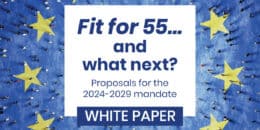EdEn believes that the energy efficiency legislation can play a key part in addressing both of the challenges the EU is currently facing:
- Climate change – Energy efficiency requirements can lead to significant reductions in fossil fuels consumption and thus contribute to GHG-emission reductions;
- Economic recovery – Energy efficiency requirements contribute to fostering technological developments, to rolling-out decarbonised and energy efficient equipment and to creating jobs in various economic sectors.
Nevertheless, energy-efficiency should always be understood as a means towards an end – climate action and economic recovery – rather than as an end in itself.
In order for the Energy Efficiency Directive (EED) to contribute to the climate neutrality objective, it is essential that a climate dimension be included in the text, which is currently not the case.
Along with the inclusion of a climate dimension in the text of the EED, the provisions related to measuring energy efficiency improvements should be based on more precise definitions as improving energy efficiency is too often confused with reducing energy consumption, while the two notions should be clearly differentiated in the directive.







